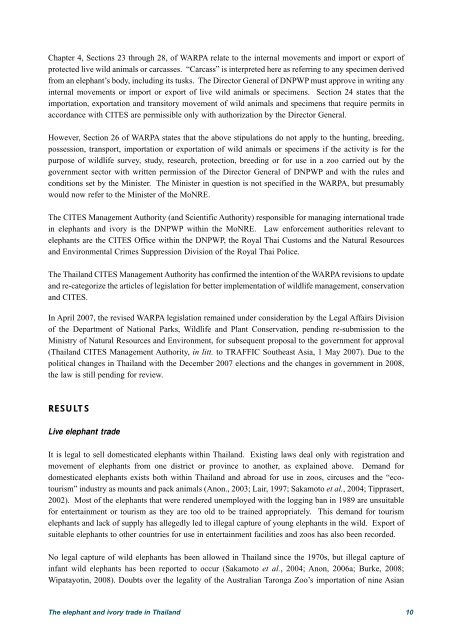The elephant and ivory trade in Thailand (PDF, 800 KB) - Traffic
The elephant and ivory trade in Thailand (PDF, 800 KB) - Traffic
The elephant and ivory trade in Thailand (PDF, 800 KB) - Traffic
You also want an ePaper? Increase the reach of your titles
YUMPU automatically turns print PDFs into web optimized ePapers that Google loves.
Chapter 4, Sections 23 through 28, of WARPA relate to the <strong>in</strong>ternal movements <strong>and</strong> import or export of<br />
protected live wild animals or carcasses. “Carcass” is <strong>in</strong>terpreted here as referr<strong>in</strong>g to any specimen derived<br />
from an <strong>elephant</strong>’s body, <strong>in</strong>clud<strong>in</strong>g its tusks. <strong>The</strong> Director General of DNPWP must approve <strong>in</strong> writ<strong>in</strong>g any<br />
<strong>in</strong>ternal movements or import or export of live wild animals or specimens. Section 24 states that the<br />
importation, exportation <strong>and</strong> transitory movement of wild animals <strong>and</strong> specimens that require permits <strong>in</strong><br />
accordance with CITES are permissible only with authorization by the Director General.<br />
However, Section 26 of WARPA states that the above stipulations do not apply to the hunt<strong>in</strong>g, breed<strong>in</strong>g,<br />
possession, transport, importation or exportation of wild animals or specimens if the activity is for the<br />
purpose of wildlife survey, study, research, protection, breed<strong>in</strong>g or for use <strong>in</strong> a zoo carried out by the<br />
government sector with written permission of the Director General of DNPWP <strong>and</strong> with the rules <strong>and</strong><br />
conditions set by the M<strong>in</strong>ister. <strong>The</strong> M<strong>in</strong>ister <strong>in</strong> question is not specified <strong>in</strong> the WARPA, but presumably<br />
would now refer to the M<strong>in</strong>ister of the MoNRE.<br />
<strong>The</strong> CITES Management Authority (<strong>and</strong> Scientific Authority) responsible for manag<strong>in</strong>g <strong>in</strong>ternational <strong>trade</strong><br />
<strong>in</strong> <strong>elephant</strong>s <strong>and</strong> <strong>ivory</strong> is the DNPWP with<strong>in</strong> the MoNRE. Law enforcement authorities relevant to<br />
<strong>elephant</strong>s are the CITES Office with<strong>in</strong> the DNPWP, the Royal Thai Customs <strong>and</strong> the Natural Resources<br />
<strong>and</strong> Environmental Crimes Suppression Division of the Royal Thai Police.<br />
<strong>The</strong> Thail<strong>and</strong> CITES Management Authority has confirmed the <strong>in</strong>tention of the WARPA revisions to update<br />
<strong>and</strong> re-categorize the articles of legislation for better implementation of wildlife management, conservation<br />
<strong>and</strong> CITES.<br />
In April 2007, the revised WARPA legislation rema<strong>in</strong>ed under consideration by the Legal Affairs Division<br />
of the Department of National Parks, Wildlife <strong>and</strong> Plant Conservation, pend<strong>in</strong>g re-submission to the<br />
M<strong>in</strong>istry of Natural Resources <strong>and</strong> Environment, for subsequent proposal to the government for approval<br />
(Thail<strong>and</strong> CITES Management Authority, <strong>in</strong> litt. to TRAFFIC Southeast Asia, 1 May 2007). Due to the<br />
political changes <strong>in</strong> Thail<strong>and</strong> with the December 2007 elections <strong>and</strong> the changes <strong>in</strong> government <strong>in</strong> 2008,<br />
the law is still pend<strong>in</strong>g for review.<br />
RESULTS<br />
Live <strong>elephant</strong> <strong>trade</strong><br />
It is legal to sell domesticated <strong>elephant</strong>s with<strong>in</strong> Thail<strong>and</strong>. Exist<strong>in</strong>g laws deal only with registration <strong>and</strong><br />
movement of <strong>elephant</strong>s from one district or prov<strong>in</strong>ce to another, as expla<strong>in</strong>ed above. Dem<strong>and</strong> for<br />
domesticated <strong>elephant</strong>s exists both with<strong>in</strong> Thail<strong>and</strong> <strong>and</strong> abroad for use <strong>in</strong> zoos, circuses <strong>and</strong> the “ecotourism”<br />
<strong>in</strong>dustry as mounts <strong>and</strong> pack animals (Anon., 2003; Lair, 1997; Sakamoto et al., 2004; Tipprasert,<br />
2002). Most of the <strong>elephant</strong>s that were rendered unemployed with the logg<strong>in</strong>g ban <strong>in</strong> 1989 are unsuitable<br />
for enterta<strong>in</strong>ment or tourism as they are too old to be tra<strong>in</strong>ed appropriately. This dem<strong>and</strong> for tourism<br />
<strong>elephant</strong>s <strong>and</strong> lack of supply has allegedly led to illegal capture of young <strong>elephant</strong>s <strong>in</strong> the wild. Export of<br />
suitable <strong>elephant</strong>s to other countries for use <strong>in</strong> enterta<strong>in</strong>ment facilities <strong>and</strong> zoos has also been recorded.<br />
No legal capture of wild <strong>elephant</strong>s has been allowed <strong>in</strong> Thail<strong>and</strong> s<strong>in</strong>ce the 1970s, but illegal capture of<br />
<strong>in</strong>fant wild <strong>elephant</strong>s has been reported to occur (Sakamoto et al., 2004; Anon, 2006a; Burke, 2008;<br />
Wipatayot<strong>in</strong>, 2008). Doubts over the legality of the Australian Taronga Zoo’s importation of n<strong>in</strong>e Asian<br />
<strong>The</strong> <strong>elephant</strong> <strong>and</strong> <strong>ivory</strong> <strong>trade</strong> <strong>in</strong> Thail<strong>and</strong> 10

















